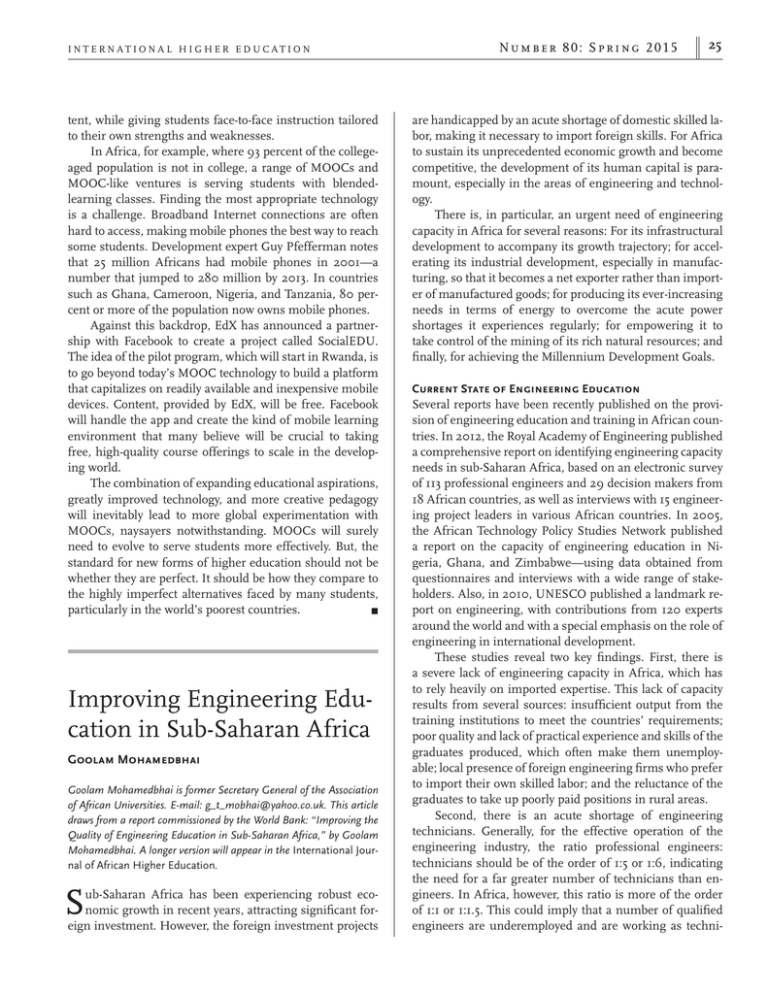Improving Engineering Edu - Open Access Journals at BC
advertisement

I N T E R N AT I O N A L H I G H E R E D U C AT I O N tent, while giving students face-to-face instruction tailored to their own strengths and weaknesses. In Africa, for example, where 93 percent of the collegeaged population is not in college, a range of MOOCs and MOOC-like ventures is serving students with blendedlearning classes. Finding the most appropriate technology is a challenge. Broadband Internet connections are often hard to access, making mobile phones the best way to reach some students. Development expert Guy Pfefferman notes that 25 million Africans had mobile phones in 2001—a number that jumped to 280 million by 2013. In countries such as Ghana, Cameroon, Nigeria, and Tanzania, 80 percent or more of the population now owns mobile phones. Against this backdrop, EdX has announced a partnership with Facebook to create a project called SocialEDU. The idea of the pilot program, which will start in Rwanda, is to go beyond today’s MOOC technology to build a platform that capitalizes on readily available and inexpensive mobile devices. Content, provided by EdX, will be free. Facebook will handle the app and create the kind of mobile learning environment that many believe will be crucial to taking free, high-quality course offerings to scale in the developing world. The combination of expanding educational aspirations, greatly improved technology, and more creative pedagogy will inevitably lead to more global experimentation with MOOCs, naysayers notwithstanding. MOOCs will surely need to evolve to serve students more effectively. But, the standard for new forms of higher education should not be whether they are perfect. It should be how they compare to the highly imperfect alternatives faced by many students, particularly in the world’s poorest countries. Improving Engineering Education in Sub-Saharan Africa Goolam Mohamedbhai Goolam Mohamedbhai is former Secretary General of the Association of African Universities. E-mail: g_t_mobhai@yahoo.co.uk. This article draws from a report commissioned by the World Bank: “Improving the Quality of Engineering Education in Sub-Saharan Africa,” by Goolam Mohamedbhai. A longer version will appear in the International Journal of African Higher Education. S ub-Saharan Africa has been experiencing robust economic growth in recent years, attracting significant foreign investment. However, the foreign investment projects Nu mb er 8 0 : Spr i n g 2 0 1 5 25 are handicapped by an acute shortage of domestic skilled labor, making it necessary to import foreign skills. For Africa to sustain its unprecedented economic growth and become competitive, the development of its human capital is paramount, especially in the areas of engineering and technology. There is, in particular, an urgent need of engineering capacity in Africa for several reasons: For its infrastructural development to accompany its growth trajectory; for accelerating its industrial development, especially in manufacturing, so that it becomes a net exporter rather than importer of manufactured goods; for producing its ever-increasing needs in terms of energy to overcome the acute power shortages it experiences regularly; for empowering it to take control of the mining of its rich natural resources; and finally, for achieving the Millennium Development Goals. Current State of Engineering Education Several reports have been recently published on the provision of engineering education and training in African countries. In 2012, the Royal Academy of Engineering published a comprehensive report on identifying engineering capacity needs in sub-Saharan Africa, based on an electronic survey of 113 professional engineers and 29 decision makers from 18 African countries, as well as interviews with 15 engineering project leaders in various African countries. In 2005, the African Technology Policy Studies Network published a report on the capacity of engineering education in Nigeria, Ghana, and Zimbabwe—using data obtained from questionnaires and interviews with a wide range of stakeholders. Also, in 2010, UNESCO published a landmark report on engineering, with contributions from 120 experts around the world and with a special emphasis on the role of engineering in international development. These studies reveal two key findings. First, there is a severe lack of engineering capacity in Africa, which has to rely heavily on imported expertise. This lack of capacity results from several sources: insufficient output from the training institutions to meet the countries’ requirements; poor quality and lack of practical experience and skills of the graduates produced, which often make them unemployable; local presence of foreign engineering firms who prefer to import their own skilled labor; and the reluctance of the graduates to take up poorly paid positions in rural areas. Second, there is an acute shortage of engineering technicians. Generally, for the effective operation of the engineering industry, the ratio professional engineers: technicians should be of the order of 1:5 or 1:6, indicating the need for a far greater number of technicians than engineers. In Africa, however, this ratio is more of the order of 1:1 or 1:1.5. This could imply that a number of qualified engineers are underemployed and are working as techni- 26 Numbe r 80: S pr ing 2015 cians. There is even a risk that the ratio will worsen, as the majority of countries are upgrading their polytechnics and technical colleges to university status for offering degrees, without providing a replacement. While Africa unquestionably needs an increased pool of excellent professional engineers, it equally needs an even greater number of practically trained, versatile technicians do not only support the professional engineers but equally service and initiate small- and medium-scale industries in order to create employment, improve the quality of life, and make fuller use of local resources. Publicly funded African tertiary education institutions have for several decades suffered from the lack of investment, and this has led to a deterioration of their infrastructure. Improving Engineering Education The reports identify a number of steps to be taken for improving engineering education and training. There is, first of all, an urgent need to upgrade the infrastructure and laboratories of the existing institutions. Publicly funded African tertiary education institutions have for several decades suffered from the lack of investment, and this has led to a deterioration of their infrastructure. The curricula of engineering courses also need to be revised. Most of them have been copied from universities in Europe or the United States, have not been updated, and are not necessarily relevant to African situations. The teaching methodology needs to be improved. Because of large student numbers, the subjects are mostly taught by the magisterial mode with hardly any opportunity for the students to discuss and interact with the lecturer or among themselves. It has been suggested that the ProblemBased Learning approach in engineering education could result in noticeable improvement in the students’ ability to solving problems and, in addition, help them to acquire certain “soft” skills such as good communication, team spirit, creativity and adaptability, and key requirements for graduate employability. Closely linked to improving teaching methodology is the need for pedagogical training of engineering lecturers. Many of them, although they may have a doctorate degree in their field, are ill-equipped to help students to learn using appropriate pedagogical techniques. Many African univer- I N T E R N AT I O N A L H I G H E R E D U C AT I O N sities are now insisting that all their lecturers should have a PhD. This may not necessarily be the right approach for all engineering lecturers and, in any case, may not be feasible. For many of them, having a good master’s degree in the appropriate field, acquiring some industrial experience and undergoing pedagogical training would better equip them for their teaching. Pedagogical training of academic staff in African universities is not widespread, although some institutions have made attempts to introduce it. Finally, all the studies highlight the importance of strong university-industry linkages. These linkages can take different forms: involving industry in advising on curricula reform; inviting representatives from industry to serve on the Faculty of Engineering board or even on the higher administrative bodies of the institution; and using professionals from business and industry as adjunct professors. Perhaps the most important role of industry is to provide practical training to the students at two different stages: during the course in the form of industrial attachments, which exposes the students to the world of work and subsequently facilitates their employment; and on completion of the course, to meet the necessary professional registration requirements. Several universities in Africa have unfortunately abandoned the in-course industrial attachments, because of the difficulty in placing the ever-increasing number of students—leaving the students to acquire training on employment after graduation. Potential for Industrial Development Africa stands at a crossroads in its development trajectory. It is widely acknowledged that its youthful population and abundant natural resources are key aspects that need to be fully exploited. Education and training, especially in engineering and technology, are necessary tools for the continent to unlock its potential. Engineering is probably an area requiring most attention, as it provides highly skilled personnel for industrial development. It, however, faces a number of challenges, which need to be addressed jointly and urgently by African governments, engineering education institutions and representatives of industry and the private sector. In parallel to improving the quality of engineering education and training, there is a need to create a dynamic industrial environment in African countries. Only then can engineering thrive and achieve its full potential. Several foreign countries, which have significant industrial and manufacturing investments or are involved in major infrastructural development in Africa, can be enormously helpful by providing professional training to African engineering students and by employing local engineering graduates whenever possible; in short by empowering African engi- I N T E R N AT I O N A L H I G H E R E D U C AT I O N neers and effecting technology transfer, vital for Africa’s economic and industrial development. To some extent, this is a “chicken-and-egg” situation, as industrial development can only take place when there is a pool of trained technical manpower, and the training of technical personnel is dependent of industry’s absorptive capacity. A national assessment of both engineering capacity and needs in African countries can be of great help toward this end. Is There a Chinese Model of a University? Qiang Zha, Jinghuan Shi, and Xiaoyang Wang Qiang Zha is an associate professor at the Faculty of Education, York University, Toronto, Canada. E-mail: qzha@edu.yorku.ca. Jinghuan Shi is a professor and executive dean of Institute of Education, Tsinghua University, Beijing, China. E-mail: shijhuan@mail.tsinghua.edu. cn. Xiaoyang Wang is an associate professor and director of Higher Education Research Institute, Tsinghua University, Beijing, China. Email: wangxy@tsinghua.edu.cn. This article is an abridged version of a chapter to be published in Handbook of the Sociology of Higher Education, Routledge. I n the past decade and a half, Chinese higher education struck the world with its amazing pace of expansion. The aggregate enrollment grew at an annual rate of 17 percent between 1998 and 2010. In the meantime, the Chinese government has been investing hugely in elite university schemes, in order to raise some universities and programs to a world-class level. This move has triggered a worldwide competition, in efforts to create world-class universities. China’s current triumph in higher education expansion has aroused some discussions and debates, over whether or not there might be an emerging Chinese model of the university. This essay provides an overview of the inquiries into this theme. Two Major Approaches to Discerning the Chinese Model Two major approaches underlie the exploration of the Chinese model: the historical-cultural approach and the sociopolitical approach. The former embeds this discourse in the Confucian knowledge tradition. In the methodological sense, a knowledge tradition embodies the enduring modes of thinking or the salient features of cultural selfunderstanding, which would inevitably function to shape Nu mb er 8 0 : Spr i n g 2 0 1 5 27 the particular contour of development in any given society. So, it is with the Confucian scholarly tradition with respect to Chinese universities. Though the university as an organizational form has been imported to Chinese soil only for a century or so; yet, as an organization of learning, it is naturally connected to the ethos of Confucian scholarship, which dominated Chinese education for over 2,000 years. Along the tradition line, the notion of liberal education now appears to be an optimal antidote to decadence in Chinese universities. Liberal education could be connected to the Confucian knowledge tradition that places emphasis on humanistic education, and thus implies learning from the past, rather than borrowing from the West. A Chinese name is often given to such practices, tong shi education, in order to differentiate it from the Western concept. Historically, China enjoyed profounder humanistic education, than Renaissance humanism in Europe. Hence, the past decade witnessed that Chinese universities had been increasingly encouraged to adopt the idea of liberal education and reorganize and broaden their curricula. Notably, many liberal education units in Chinese universities name themselves shuyuan (private academies of classical learning that flourished in the Tang and Song dynasties), in a deliberate effort at linking themselves to the Confucian tradition. The historical-cultural approach draws heavily on the conception of the ideal type. The ideal type is often a useful tool to analyze historically unique configurations, by means of generic concepts. Nonetheless, it is argued that the current Chinese university may hardly be able to claim an ideal type formed from characteristics of and elements in the Confucian tradition—after a century of experimenting with various Western and Soviet patterns and absorbing their influences. The shuyuan, even if recovered, has lost its cultural milieu in contemporary Chinese society. So, not surprisingly, research has indicated the impact of tong shi education in a current context as superficial, based on its utilitarian approaches associated with political agenda of creating “world-class” universities or marketing the goal of particular branding campaigns. As such, tong shi education has become more a matter of rhetoric than reality and failed to bring about significant transformation in the students’ learning experiences. The contemporary sociopolitical approach holds that the Chinese model for sociopolitical development (or the “Beijing Consensus”), which constitutes the normative environment in which Chinese universities operate, denotes a central role of the state and places emphasis on efficiency for the sake of accelerating economic growth. This model certainly finds its expression in Chinese universities. It carries advantages with respect to effective mobilization of resources and the capacity to expand and upgrade infrastructure dramatically in a short timeline. Consequently, the





